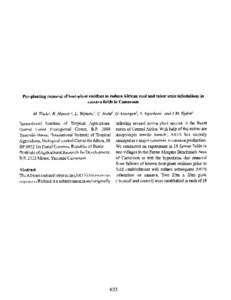| dc.contributor.author | Tindo, M. |
| dc.contributor.author | Hanna, R. |
| dc.contributor.author | Wijnans, L. |
| dc.contributor.author | Nolte, C. |
| dc.contributor.author | Goergen, Georg E. |
| dc.contributor.author | Nguekam, A. |
| dc.contributor.author | Ngeve, J.M. |
| dc.date.accessioned | 2019-12-04T11:14:19Z |
| dc.date.available | 2019-12-04T11:14:19Z |
| dc.date.issued | 2007 |
| dc.identifier.citation | Tindo, M., Hanna, R., Wijnans, L., Nolte, C., Goergen, G., Nguekam, A. & Ngeve, J.M. (2007). Pre-planting removal of host-plant residues to reduce African root and tuber scale infestations in cassava fields in Cameroon. In Proceedings of the 9th ISTRC-AB Symposium (pp. 633-639), 1-5 November, Mombasa, Kenya. |
| dc.identifier.uri | https://hdl.handle.net/20.500.12478/2730 |
| dc.description.abstract | The African root and tuber scale (ARTS) Stictococcus vayssierei Richard is a subterranean insect originally infesting several native plant species in the forest zones of Central Africa. With help of the native ant Anoplolepis tenella Santchi, ARTS has recently emerged as a major constraint to cassava production. We conducted an experiment in 18 farmer fields in two villages in the Forest Margins Benchmark Area of Cameroon to test the hypothesis that removal from fallows of known host-plant residues prior to field establishment will reduce subsequent ARTS infestation on cassava. Two 20m x 20m plots ('treated' and control) were established in each of 18 fields. Both plots were prepared and subsequently managed by the farmer according to field practices prevalent in the area. In the 'treated' plot, however, all host-plant residues were removed thoroughly prior to cassava planting. Densities of ARTS and its associated ant were determined on a sample of ten plants in each plot at three, six and nine months after planting (MAP). Overall average ARTS density per plant was not significantly different between treated and control plots. However, variation in ARTS densities between fields within a village was high, and in several fields ARTS densities were
significantly higher in one plot compared with the other. ARTS densities were higher in control than in treated plots in 4 out of 18 fields, while higher scale densities occurred in treated compared with control plots in one field. ARTS densities did not differ between plots in the remaining 13 fields. These results indicated that removal of host-plant residues before planting as it was practiced in this study cannot significantly reduce ARTS infestations on cassava. Explanations and recommendations are provided for further testing of the impact of pre-planting host-plant residue removal on ARTS infestations in cassava fields in Central Africa. |
| dc.description.sponsorship | International Fund for Agricultural Development |
| dc.description.sponsorship | Austrian Development Agency |
| dc.format.extent | 633-639 |
| dc.language.iso | en |
| dc.publisher | International Society For Tropical Root Crops-Africa Branch |
| dc.subject | Cassava |
| dc.subject | Plant Diseases |
| dc.subject | Fallow |
| dc.subject | African Root And Tuber Scale |
| dc.subject | Host-Plant Residues |
| dc.subject | Cassava Fields |
| dc.title | Pre-planting removal of host-plant residues to reduce African root and tuber scale infestations in cassava fields in Cameroon |
| dc.type | Conference Paper |
| dc.description.version | Peer Review |
| cg.contributor.affiliation | International Institute of Tropical Agriculture |
| cg.contributor.affiliation | Institute of Agricultural Research for Development, Cameroon |
| cg.coverage.region | Africa |
| cg.coverage.region | Central Africa |
| cg.coverage.country | Cameroon |
| cg.authorship.types | CGIAR and developing country institute |
| cg.iitasubject | Cassava |
| cg.iitasubject | Plant Diseases |
| cg.howpublished | Formally Published |
| cg.publicationplace | Mombasa, Kenya |
| cg.accessibilitystatus | Limited Access |
| local.dspaceid | 93711 |
| cg.targetaudience | Scientists |

